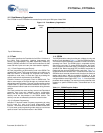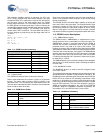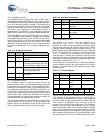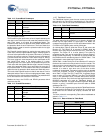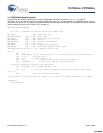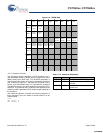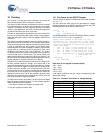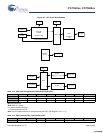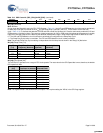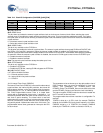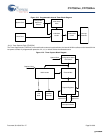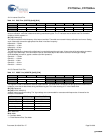
CY7C601xx, CY7C602xx
Document 38-16016 Rev. *E Page 21 of 68
12. Clocking
The enCoRe II LV has two internal oscillators, the internal 24
MHz oscillator and the 32 kHz low power oscillator.
The internal 24 MHz oscillator is designed such that it is trimmed
to an output frequency of 24 MHz over temperature and voltage
variation. The internal 24 MHz oscillator accuracy is 24 MHz
–22% to +10% (between 0° and 70°C). No external components
are required to achieve this level of accuracy.
Firmware is responsible for selecting the correct trim values from
the user row to match the power supply voltage in the end appli-
cation and writing the values to the trim registers IOSCTR and
LPOSCTR.
The internal low speed oscillator of nominally 32 kHz provides a
slow clock source for the enCoRe II LV in suspend mode, partic-
ularly to generate a periodic wakeup interrupt and also to provide
a clock to sequential logic during power up and power down
events when the main clock is stopped. In addition, this oscillator
can be used as a clocking source for the Interval Timer clock
(ITMRCLK) and Capture Timer clock (TCAPCLK). The 32 kHz
low power oscillator can operate in low power mode or provide a
more accurate clock in normal mode. The internal 32 kHz low
power oscillator accuracy ranges from –53.12% to +56.25%. The
32 kHz low power oscillator can be calibrated against the internal
24 MHz oscillator or another timing source, if desired.
enCoRe II LV provides the ability to load new trim values for the
24 MHz oscillator based on voltage. This allows Vdd to be
monitored and have firmware trim the oscillator based on voltage
present. The IOSCTR register is used to set trim values for the
24 MHz oscillator. enCoRe II LV is initialized with 3.30V trim
values at power on, then firmware is responsible for transferring
the correct set of trim values to the trim registers to match the
application’s actual Vdd. The 32 kHz oscillator generally does
not require trim adjustments for voltage but trim values for the 32
kHz are also stored in Supervisory ROM.
To improve the accuracy of the IMO, new trim values are loaded
based on supply voltage to the part. For this, firmware needs to
make modifications to two registers:
1. The internal oscillator trim register at location 0x34.
2. The gain register at location 0x38.
12.1 Trim Values for the IOSCTR Register
The trim values are stored in SROM tables in the part as shown
in Figure 11-3.
The trim values are read out from the part based on voltage
settings and written to the IOSCTR register at location 0x34. The
following pseudo code shows how this is done.
_main:
mov A, 2
mov [SSC_BLOCKID], A
Call SROM operation to read the SROM table (Refer to section
SROM Table Read Description on page 19)
//After this command is executed, the trim
//values for 3.3, 3.0, 2.85 and 2.7 are stored
//at locations FC through FF in the RAM. SROM
//calls are explained in the previous section of
//this data sheet
; mov A, [FCh] // trim values for 3.3V
mov A, [FDh] // trim values for 3.0V
; mov A, [FEh] // trim values for 2.85V
; mov A, [FFh] // trim values for 2.70V
mov reg[IOSCTR],A // Loading IOSCTR with
// trim values for
// 3.0V
.terminate:
jmp .terminate
Gain value for the register at location [0x38]:
3.3V = 0x40
3.0V = 0x40
2.85V = 0xFF
2.70V = 0xFF
Load register [0x38] with the gain values corresponding to the
appropriate voltage.
Table 12-1. Oscillator Trim Values vs. Voltage Settings
Supervisory ROM Table Function
Table2 FCh 24 MHz IOSCTR at 3.30V
Table2 FDh 24 MHz IOSCTR at 3.00V
Table2 FEh 24 MHz IOSCTR at 2.85V
Table2 FFh 24 MHz IOSCTR at 2.70V
Table3 F8h 32 kHz LPOSCTR at 3.30V
Table3 F9h 32 kHz LPOSCTR at 3.00V
[+] Feedback [+] Feedback





